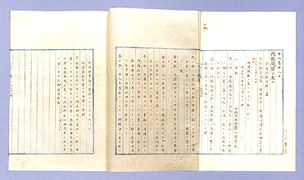|
The past governmental system in accordance with the so-called Gokajyou-no-Goseimon or Charter Oath of March 14, 1868 was replaced by the Cabinet system on December 22, 1885. The 69th Instruction of Dajokan issued on that day stated as follows. (1) To abolish government posts of the Grand Ministers of State, the Ministers of the Left and Right, the Councillors and the Lords of each Ministry, and establish posts of the Prime Minister and the Ministers of Imperial Household, Foreign Affairs, Interior, Finance, Army, Navy, Justice, Education, Agriculture and Commerce, and Posts and Telecommunications. (2) To form the Cabinet with the Prime Minister and Ministers (excluding Imperial Household Minister).
A former Councillor Hirobumi Ito was appointed as founding Prime Minister.
Along with the establishment of the Cabinet system, Naikaku-shokken (Naikaku means the Cabinet), a guideline for management of the newly created Cabinet system, was enacted on December 22, 1885. Comprised of seven articles, this guideline for the operation of the new Cabinet mainly clarified the authority and responsibility of the Prime Minister. It is worth noting that Prime Minister's authority to control other Ministers was considerably strong as compared to that in Naikaku-kansei, a successor ordinance of later years.
More specifically, the Prime Minister was given the following authority.
Each Minister was obliged to "report the Prime Minister on the state of his or her duties in a timely manner." (Article 6)
|
